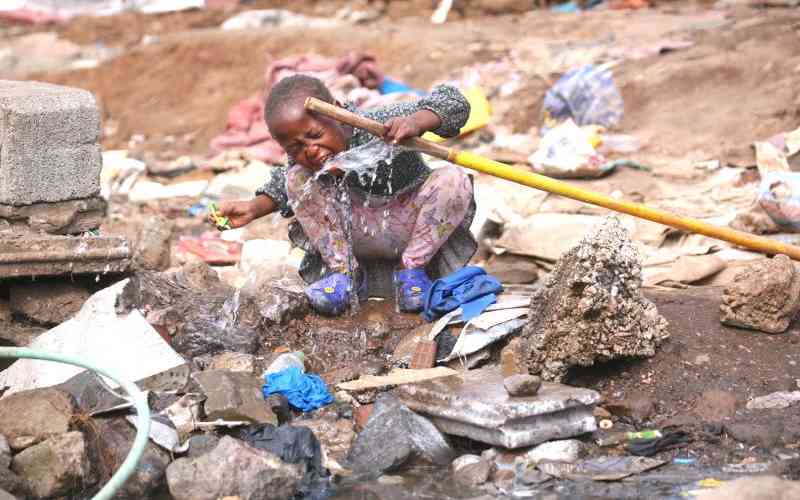Let us all strive to make the future of our children better
Opinion
By
Shaheen Nilofer and Pornpun Jib Rabiltossaporn
| Nov 19, 2024

In November 1989, world leaders made a historic commitment to children by adopting the United Nations Convention on the Rights of the Child (UNCRC), an international agreement that promised to protect children’s rights. Since then, the UNCRC has become the most universally accepted human rights treaty in history.
Kenya became a signatory to the UNCRC in 1990. In 2022, the revision of the 2001 Children Act enshrined the specific legislation safeguarding the rights and welfare of children in Kenya.
Kenya’s development depends on the country's healthy, well-educated, skilled and future-fit workforce. But the burden of poverty that the country continues to face is weighing down the potential of our children’s futures. While Kenya has seen multi-dimensional poverty in children reduce from 59.3 per cent in 2009 to 47.7 per cent in 2019, an estimated 10.5 million children are still at risk of not achieving their potential in life without urgent action.
Thirty-four years after Kenya ratified the UNCRC, some progressive strides have been made in improving child-related indicators across sectors globally. However, inequities between countries and within countries are a significant concern. The challenges facing children everywhere are becoming even more complex, given the pressing impacts of climate change, protracted humanitarian conflicts, demographic movements, technological advancements, rapid urbanisation, displacement, and severely constrained fiscal envelopes, among other issues.
The country reports mixed results regarding how Kenya tracks against the SDGs, with some indicators showing progress. In contrast, some have shown stagnation or reversals. For example, overall poverty and maternal and neonatal mortality have shown improvement. Access to healthcare, basic services (water, sanitation, hygiene, and electricity), school enrolment and completion rates have also improved. However, poverty in the rural populations, under-nourishment, and general food insecurity has worsened.
READ MORE
Pesaflix, one of the first video on demand application to revolutionize entertainment industry
Sony Sugar posts Sh113m profit after a decade of losses
What KNBS numbers reveal about economy in first 2 years under Ruto
CBK faces litmus test in fresh multi-billion-coin minting tender
Kenya tops African venture funding in 2024 with Sh82b
Kenya to legalise cryptocurrencies, says Treasury Cabinet Secretary
Mombasa port handled record 41.1m tonnes of cargo in 2024
KenGen to ramp up geothermal output with Hell's Gate project
Impact of Gen Z protests ripples through real estate
Why Sh1.4b cruise ship terminal is yet to bear fruit for Kenyans
Kenya has sustained an impressive reduction in stunting (low height for age due to chronic under-nutrition), which dropped from 26 per cent to 18 per cent between 2014 and 2022. Under-five mortality has also halved from 115 per 1,000 live births in 2003 to 47 per 1,000 live births in 2023. But the decline in neonatal mortality has been much slower, and the vast majority (70 per cent) of all child deaths are still being caused by preventable diseases such as diarrhoea, pneumonia (acute respiratory infections), malnutrition, anaemia, malaria, measles, HIV, and tuberculosis.
Poverty alleviation efforts in the past two years include the government’s expansion of the Cash Transfer Programme (Inua Jamii) from 1.2 million households in 2022 to 1.7 million in 2024. Inua Jamii caters for the most vulnerable members of society, including children, orphans, people with disabilities, and the elderly to cushion them from poverty. The government’s commitment to expanding Inua Jamii’s coverage to 2.5 million households by 2026 and prioritising poor families with children and those with a high degree of vulnerability is laudable considering that children comprise 42 per cent of the Kenyan population. Sustaining this programme in the coming years is crucial to lifting millions of people from poverty.
In addition, a plan to end the Triple Threat (new HIV infections, gender-based violence, and teenage pregnancy) against girls and women by 2027 was launched in 2023. The plan focuses on empowering adolescents and young people while safeguarding them from health vulnerabilities.
In Kenya, only 50 per cent of rural schools have basic sanitation facilities. This makes it difficult for girls to manage their menstrual hygiene needs, forcing them to miss school during their periods, or even leading to dropouts. We need renewed commitments to unlock investments towards providing adequate hygiene and sanitation facilities in schools to ensure they are conducive to learning.
The number of girls and women subjected to female genital mutilation (FGM) has significantly dropped from 38 per cent in 1998 to 15 per cent in 2022. However, violence against children remains prevalent as nearly 30 per cent of girls and 38 per cent of boys reported suffering violence in their homes from parents, caregivers, or adult relatives. Increasing the child protection workforce and rolling out the National Parenting Programme will help curb incidences of violence against children.
The government has legislated many new progressive laws since signing the UNCRC in 1990 such as the Basic Education Act of 2013, the 2016 Water Act, and the 2017 Health Act. However, these normative frameworks require adequate funding and allocation of public resources in future. At the national level, social spending increased from 33 per cent to 43.7 per cent between 2014/15 to 2022/23, while at the county level, social spending improved from 39.7 per cent to 41.7 per cent over the same period. Therefore, given fiscal constraints, protecting budgets and ensuring that investments toward children are increased and sustained moving forward is imperative.
The Summit of the Future in New York, held in September this year, sought to forge an international consensus on delivering a better reality for children now and safeguarding their future. It presented an opportunity for world leaders to re-commit to SDGs 2030 for children with a focus on ending hunger and malnutrition, building peace, making science and technology more accessible and inclusive, reducing poverty and inequality by removing barriers that limit children’s potential and addressing the negative impacts of climate change.
On the occasion of UNCRC’s 35th anniversary, we need to remember that children represent our collective future. Now, more than at any time in history, they need to be at the centre of societal commitments. Governments, development actors, civil society, the donor community – all of us - must ensure that children’s ability to thrive and reach their full potential is at the heart of our actions.
Ms Nilofer is a Representative of UNICEF Kenya and Ms Rabiltossaporn is the Country Director, Save the Children Kenya and Madagascar

